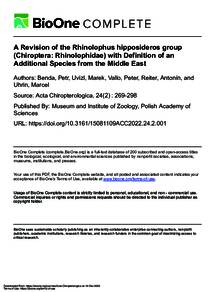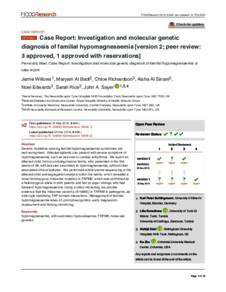Document
A Revision of the Rhinolophus hipposideros group (Chiroptera: Rhinolophidae) with definition of an additional species from the Middle East.
Contributors
Publisher
BioOne Digital Library.
Gregorian
2023-02
Language
English
English abstract
Initially, the Rhinolophus hipposideros group was defined by two morphological traits, the structure of the nose-leaf and the shape of basioccipital bone of the skull. Originally, it consisted of two species, R. hipposideros and R. midas, whereas currently it is considered to contain a single species, R. hipposideros, under whose rank both original species have been joined. The interpretation of geographic variability within the group has traditionally been based on variation in body and skull size, nose-leaf shape, and several selected skull and tooth characters. This approach resulted in delimitations of up to seven subspecies, mostly in the
Mediterranean area, a conception introduced more than a hundred years ago and accepted by many authors till today. We investigated
the phylogenetic relationships among populations of R. hipposideros with the help of molecular genetic, morphological, and acoustic
examinations. Our analysis uncovered the existence of an unexpected diversity within the R. hipposideros group, challenging its
current phylogenetic and taxonomic arrangements. The molecular genetic analysis of almost 100 samples and morphological
examinations of about 300 specimens showed two main, geographically exclusive, phylogenetic lineages within the group, well
delimited by molecular characteristics and possessing two distinct morphotypes and two distinct echotypes. These two lineages are
isolated deep enough to be considered separate species. One of them, R. hipposideros s.str., is widespread over the south-western Eurasia and north-western and north-eastern Africa, and the other, R. midas, is distributed in a small range around the Strait of Hormuz and Gulf of Oman. The extensive range of R. hipposideros s.str. is inhabited at least by two subspecies, separated mainly by the genetic characters, whereas the morphological and echolocation traits do not distinguish the populations sufficiently. The western R. h. hipposideros occurs in the Maghreb and Europe west of the Dnieper River, Bosporus, and the Strait of Karpathos, and the eastern R. h. minimus lives east of this boundary, including the populations of Crimea, Caucasus, the Middle East, and north-eastern Africa (Sudan to Djibouti). The two subspecies also differ in karyotype, with 2n = 58 in R. h. minimus and 2n = 54–56 in R. h. hipposideros. The taxonomic position of the easternmost populations of R. hipposideros s.str. (West Turkestan, Afghanistan, Kashmir) remains unresolved and has to be investigated more elaborately and using a more extensive sample set.
Member of
Resource URL
Category
Journal articles



